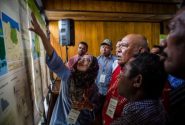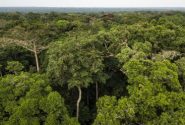
Many have criticised the outcomes of COP18 in Doha. Omar Chatriwala
DOHA, Qatar (11 December, 2012)_While the U.N. climate talks in Doha saw no decision on verifying carbon emissions from deforestation, forests look set to be an integral part of the next international treaty on climate change in 2020, experts said.
“Overall, it has been a disappointing set of outcomes for forests, in particular because there has been no decision on measurement, reporting and verification (MRV) of emissions reductions. This is the final element required for REDD+ demonstration activities to get underway in earnest,” said Louis Verchot, Director of Forest and Environment research at the Center for International Forestry Research (CIFOR).
“However, it does look like forests and REDD+ are going to be considered as an integral part of the next international treaty on climate change in 2020.”
After a lengthy and hard-fought negotiation process, 35 countries signed on to a second commitment period of the Kyoto Protocol – the only legally binding agreement under which developed countries have committed to cut their greenhouse gases.
Currently deforestation and forest degradation account for 11-15 percent of global greenhouse gas emissions (see here and here) however, these emissions are not part of the control measures under the Kyoto Protocol. Despite this, many countries are sill reducing emissions from deforestation through schemes such as REDD+, which sees money channeled to developing countries to keep their forests standing.
With the second extension of Kyoto ending in 2020, the intention is to replace it with a new climate treaty based on the Durban Platform. The new treaty would see both developed and developing countries make emissions reductions commitments over the next two years.
But ambition to make such commitments was clearly lacking in Doha.
It does look like forests and REDD+ are going to be considered as an integral part of the next international treaty on climate change in 2020.
One of the main reasons for the delay is the blame-game being played between developed and developing countries, said Arild Angelsen, professor of economics at the Norwegian University of Life Sciences (UMB) and a senior associate at CIFOR, with most countries trying to do as little as possible while pushing others to do as much as possible.
“The UN system, including the UN Framework Convention on Climate Change is based on a simple division of the world in developed and developing countries. This is outdated. China is the largest emitter and has, even on a per capita basis, reached the EU level,” he said.
“Most future emission increases are expected in middle-income countries. While the Kyoto extension segments this division, the Durban platform represents a step to overcome it.”
According to Verchot, countries may have also been hesitant to commit to emissions reductions in Doha because they are unsure of how to cut emissions efficiently in different sectors and they are unsure of the costs.
To encourage both developed and developing nations to set and commit to targets, several workshops were proposed in the final decision at Doha (read the texts here and here) that will allow countries to look at different industries such as forestry, agriculture and energy to better understand where and how they can afford to change practices in these sectors to cut their emissions.
Forestry workshop in 2013 will help integrate forests into global climate agreement
Over the next two years, negotiations on the new climate treaty will be split into two “workstreams” – one looking at actions that the international community will undertake to combat climate change from 2020 and another to look into activities in certain sectors, including a workshop on forestry, which could encourage emissions cuts under the new climate agreement.
“The workshops under the Durban Platform will discuss mitigation issues and increasing ambition to reduce emissions in the forestry sector. At the same time they need to address the needs of developing countries in adapting to climate change.”
While the agenda of the forestry workshop has yet to be decided, Verchot hopes it will tackle issues that remain unresolved from Doha, such as the verification of carbon emissions.
MRV: small steps forward but verification still a major sticking point
Many were expecting Doha to build on the robust decisions made in Durban on monitoring, reporting and verification (MRV) of carbon emissions. Unfortunately, progress on MRV at Doha was incremental, said Verchot.
“There was progress on how carbon measurements would be linked with setting reference emissions levels – the baseline from which countries measure their success in reducing emissions. Making it explicit that consistent and similar methods need to be used in all countries was certainly a step forward.”
But the question marks hanging over financing and verification stymied the effort to wrap up the decisions on MRV, which is the key element needed to get REDD+ pilot actions going.
“When the discussion turned to verification of carbon emissions, the negotiators linked this to financing and the talks ground to a halt,” he added.
The impasse – reported to be between Brazil (a potential beneficiary of REDD+) and Norway (the largest funder of tropical forest conservation) — revolved around language governing the standards by which deforestation-related emissions would be verified.
Norway has been pushing for an independent, international verification process undertaken by experts, whereas Brazil and other developing nations said that they were not willing to commit to external verification requirements.
The absence of an agreement on verification will be a major setback for forest-rich countries moving ahead with REDD+ implementation in a few years.
When the discussion turned to verification of carbon emissions, the negotiators linked this to financing and the talks ground to a halt.
“Many countries don’t have technological capacities of Brazil or Indonesia and this is going to hold them up in being able to move forward to the REDD+ implementation phase in a few years time.”
Hopefully next year’s forestry workshop can also tackle this issue, Verchot said.
“Countries will have to come to a compromise on the scope of international verification. Perhaps the sticking point is deciding how independent the process needs to be and how much can be achieved through bilateral agreements.”
Green climate fund: a promising sign for forests but needs support of U.S.
Countries struggled to come to an agreement on other financial matters in Doha. The decision from the conference (read it here) encourages developed countries to keep financial commitments steady over the next two years; however, identifying new sources of funds has been bumped to next year.
Finance is the most uncertain element and the number one impediment to making progress on the ground in countries with high deforestation rates. The concern is that due to a lack of meaningful commitments to reduce greenhouse gas emissions by 2015, progress on REDD+ may be held hostage to other key financial decisions, like where money for the Green Climate Fund (GCF) will come from.
It was announced in Doha that the GCF will start its work in Sondgo, South Korea, in the second half of 2013, with an aim to launch activities in 2014. The GCF’s coffers are still empty, however there is hope that a proportion of funds will be earmarked for forest-climate mitigation mechanisms such as REDD+.
While there was no clear indication in Doha of how countries will achieve a promised tenfold increase in aid to reach the promised $100 billion a year by 2020 to support the Durban Platform, it is hoped that GCF will help move these decisions along.
“You have 30 or 40 countries within the [GCF] board…it is more manageable and more practical [to make financial decisions] but it is also passing the buck, so at some point the [UNFCCC] will have to decide about long-term finance,” said Tony La Vina, negotiator for the Philippines.
However the lack of emissions reductions commitments from the U.S. for the past few years puts decisions on finance into question, since many emerging economies like China and India who have only recently become high carbon emitting countries are loath to act until historical emitters, like the U.S., make a move.
“REDD+ financing will be held hostage until these larger political issues can be sorted out,” Verchot said.
In the absence of a comprehensive climate change agreement, experts are still confident the scheme can still move forward on the ground.
“Many are already successfully tackling deforestation with the help of REDD+. Much is already being achieved independently of the UNFCCC and in the absence of an international climate agreement,” Verchot said.
“But at least the door is open to integrating forests into the new climate treaty.”
We want you to share Forests News content, which is licensed under Creative Commons Attribution-NonCommercial-ShareAlike 4.0 International (CC BY-NC-SA 4.0). This means you are free to redistribute our material for non-commercial purposes. All we ask is that you give Forests News appropriate credit and link to the original Forests News content, indicate if changes were made, and distribute your contributions under the same Creative Commons license. You must notify Forests News if you repost, reprint or reuse our materials by contacting forestsnews@cifor-icraf.org.












